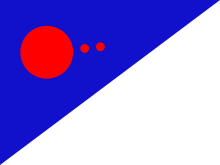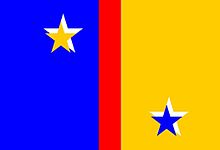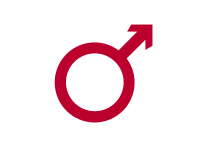- Flag of Mars
-
The flag of Mars is a tricolour used by the Mars Society and The Planetary Society to represent the planet Mars. It is not official in any legal sense, as the Outer Space Treaty forbids the appropriation of celestial bodies by any means.[1]. However, it has been used by the Mars Society and The Planetary Society.
Contents
Design
The flag is designed to portray the "future history" of Mars. The red bar, which lies closest to the mast, symbolizes Mars as it is today. The green and blue symbolize stages in the possible terraforming of Mars should humanity ever have the will and the ability to undertake such a task, the ethics of terraforming remaining a matter of debate. Kim Stanley Robinson's popular trilogy Red Mars, Green Mars, and Blue Mars provided the concept for the flag. The design was originally proposed by NASA engineer Pascal Lee, during a summer 1999 expedition to Devon Island, Canada, as task force leader for the Mars Society's Mars Arctic Research Station project.
Use
The flag now flies over the Flashline Mars Arctic Research Station on Devon Island, and is displayed in several places on the Mars Desert Research Station campus in Utah. It has also flown in space, carried aboard the space shuttle Discovery by astronaut John M. Grunsfeld on STS-103 in 1999.
Official status
There is no official flag for Mars since there is no government or other authority in existence capable of adopting such a flag. In addition, the Outer Space Treaty states in Article II that "outer space, including the Moon and other celestial bodies, is not subject to national appropriation by claim of sovereignty, by means of use or occupation, or by any other means."
Alternatives
Though it has been used by both the Mars Society and The Planetary Society, there are a number of members who disapprove the current design. A member of the German chapter of the Mars Society backs the idea of redesigning the flag. Apart from the colors not harmonizing he opines that the flag lacks in symbolism. Therefore a flag was designed, which was released on Facebook with a view to start rethinking. He makes use of the colors blue and gold, which are almost complementary on the color wheel and thus harmonize very well.
Flag description:
“ The blue is on the hoist side while the gold is on the fly. The upper hoist canton has a golden five-pointed star on white ground. Likewise there is a blue star in the lower fly canton. The color gold stands for glory, tribute, success and (seen as yellow) for the sun or solar system. On the other hand the blue is a symbol for desire (wanderlust), the sky, water (and thus for our Earth), satisfaction and not least knowledge. The two stars symbolize the solar system too or rather astronautics at large. They also stand for our two worlds – Earth and Mars. Interpreted like military stars they stand for scientific achievements and honor associated with a future Mars mission.
” After receiving some feedback he decided to add a simple strip of red between the blue and the gold. He explains his modification as follows:
“ The red symbolizes a barrier between the solar system and Earth, which is not necessarily insuperable. Furthermore red is also the color of Mars and thus not misplaced. In color psychology red is seen as a warning color (e.g. „marsforming“ of Earth), which reminds us of possible problems and obstacles.
” Red is – as he says - also the color for two important emotions:
- Friendship and Love: In his opinion “important to ensure the essential international cooperation needed for a Mars mission”.
- Aggression: In his opinion “[t]hese plans must be carried out aggressively otherwise they are doomed to fail”.
The idea was to create a flag that doesn’t resemble any national one – the only flag, however, using similar colors is the Ukrainian, which has a different alignment. Moreover the flag is easily distinguishable even when used in black and white only.
Fictional Mars flags
 One interpretation of the Flag of the Federal Republic of Mars, as described in the book Moving Mars
One interpretation of the Flag of the Federal Republic of Mars, as described in the book Moving Mars
In his science-fiction novel Moving Mars, Greg Bear describes the flag of the fictional Federal Republic of Mars as follows: "red Mars and two moons in blue field above a diagonal, white below".
In Robert A. Heinlein's novel Stranger in a Strange Land, a flag of Mars is hastily improvised, consisting of the "traditional human symbol for Mars" in red on a white sheet.[2]
See also
References
- ^ Treaty on Principles Governing the Activities of States in the Exploration and Use of Outer Space, including the Moon and Other Celestial Bodies United Nations Office for Outer Space Affairs. Retrieved: 2011-05-26.
- ^ Stranger in a Strange Land at Flags of the World. Retrieved on 2011-03-01.
- Further reading
Mars Areography General- Observation history
- Albedo features (Solis Lacus)
- Atmosphere
- Canals (list)
- Climate
- Color
- Water
- Glaciers
- Life
- North Polar Basin
- Chaos terrain
- Noachian
- Soil
Regions- Alba Mons
- Albor Tholus
- Arsia Mons
- Ascraeus Mons
- Biblis Tholus
- Elysium Mons
- Hecates Tholus
- Olympus Mons
- Pavonis Mons
- Syrtis Major Planum
- Tharsis
- Tharsis Montes
- North Polar Basin
- Hellas Planitia
- Argyre Planitia
- Schiaparelli
- Gusev
- Eberswalde
- Bonneville
- Eagle
- Endeavour
- Endurance
- Erebus
- Victoria
- Gale
- Galle
- Ibragimov
- Santa Maria
- Valles
- Chasmata
- Outflow channel
- Valles Marineris
Moons Specific- Phobos
- (Features
- Stickney crater
- Monolith)
- Deimos
- (Features)
CommonExploration Past and
CurrentFutureAstronomy EclipsesAsteroidsMeteorites Other topics - Darian calendar
- Timekeeping on Mars
- Flag of Mars
- In Fiction
- Martian
- Mars Society
- (FMARS
- MDRS)
- Mars Institute
- (Haughton–Mars Project)
- Mythology
- Ocean Hypothesis
Categories:
Wikimedia Foundation. 2010.




